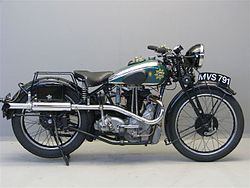
A motorcycle engine is an engine that powers a motorcycle. Motorcycle engines are typically two-stroke or four-stroke internal combustion engines, but other engine types, such as Wankels and electric motors, have been used.

Phillip William Read, is an English former professional motorcycle racer. He competed in Grand Prix motorcycle racing from 1961 to 1976. Read is notable for being the first competitor to win world championships in the 125 cc, 250 cc and 500 cc classes. Although he was often overshadowed by his contemporary, Mike Hailwood, he won seven FIM Grand Prix road racing world championships. In 2013, Read was named an FIM Legend for his motorcycling achievements.

The Triumph Trident and BSA Rocket 3 was a technically advanced, high-performance roadster motorcycle made by Triumph Engineering and BSA from 1968 to 1975, and sold under both the Triumph and BSA marques. Alongside the Honda CB750, and later the Kawasaki triples, it brought a new level of sophistication to street motorcycles, marking the beginning of the superbike era. The Honda CB750 overshadowed the Trident to be remembered as the 'first superbike', in spite of the Triumph Trident actually debuting before the Honda by a few weeks.

Associated Motor Cycles (AMC) was a British motorcycle manufacturer founded by the Collier brothers as a parent company for the Matchless and AJS motorcycle companies. It later absorbed Francis-Barnett, James, and Norton before incorporation into Norton-Villiers. Henry Herbert Collier founded Matchless as a cycle company in 1878. His sons Henry (Harry) and Charles (Charlie) joined him and the name was changed to H. Collier & Sons.

The BSA Gold Star is a motorcycle made by BSA from 1938 to 1963. They were 350 cc and 500 cc single-cylinder four-stroke production motorcycles known for being among the fastest bikes of the 1950s. Being hand built and with many optional performance modifications available, each motorcycle came from the factory with documented dynamometer test results, allowing the new owner to see the horsepower (bhp) produced.
Walter Leslie Handley born in Aston, Birmingham, known as Wal Handley, was a champion British inter-war motorcycle racer with four wins at the Isle of Man TT Races in his career. Later he also raced cars in the 1930s, and died in a World War II aircraft accident while serving as pilot with the Air Transport Auxiliary.
FN is a Belgian company established in 1889 to make arms and ammunition, and from 1901 to 1967 was also a motorcycle manufacturer. FN manufactured one of the world's first four-cylinder motorcycles, was famous for the use of shaft drive in all models from 1903 to 1923, achieved success in sprint and long-distance motorcycle racing, and after 1945, also in motocross.
Greeves Motorcycles was a British motorcycle manufacturer founded by Bert Greeves which produced a range of road machines, and later competition mounts for observed trials, scrambles and road racing. The original company produced motorcycles from 1952, funded by a contract with the Ministry of Pensions for their Invacar, a three-wheeler for disabled drivers.
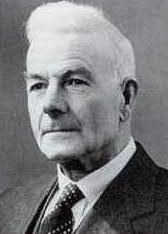
Valentine Page (1891–1978) was a British motorcycle designer, who worked for several of the UK's leading marques, including Ariel, Triumph, and BSA. Page was an innovator whose radical designs include the Triumph 6/1, BSA Gold Star, BSA A7 and BSA M20, the J.A.Prestwich engine of the Brough Superior SS100, and the Ariel Leader.

The Velocette Venom was a 499 cc single-cylinder four-stroke British motorcycle made by Velocette at Hall Green in Birmingham. A total of 5,721 machines were produced between 1955 and 1970.
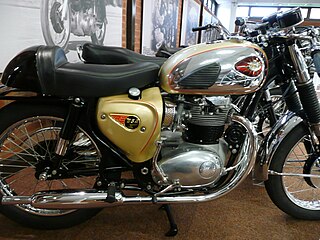
The BSA Lightning Clubman was a 650cc British motorcycle made by BSA at their factory in Birmingham between 1964 and 1965. Finished in gold and black the Lightning Clubman is now a highly sought after classic motorcycle. Due to the very limited production numbers replicas are created by enthusiasts from the BSA Lightning.

The BSA A7 was a 500cc motorcycle model range made by Birmingham Small Arms Company (BSA) at their factory in Armoury Road, Small Heath, Birmingham. The range was launched in 1946 using a 495 cc (30.2 cu in) long stroke engine. An improved 497 cc (30.3 cu in) version based on the BSA A10 engine was launched in 1950. The various A7 models continued in production with minor modifications until 1961/2 when they were superseded by the unit-construction A50 model.
The BSA B50 was a single-cylinder 499 cc (30.5 cu in) ohv motorcycle, produced by BSA at their factory in Small Heath, Birmingham. The last of the big capacity unit-construction singles from the Birmingham Small Arms company, it had an alloy engine with a bore of 84 mm (3.3 in) and a stroke of 90 mm (3.5 in). As well as the road version, special models were produced for off-road competition use.
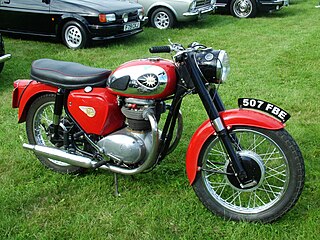
The BSA A65 Star was a Birmingham Small Arms Company (BSA) motorcycle aimed at the US market for unit construction twins. As well as giving a clean look to the engine, with the pushrod passages part of the cylinder block casting, unit construction reduced the number of places oil could leak from. A range of A65 Star twins was produced between 1962 and 1972.
Albert (Bert) Perrigo (1903–1985) was a British engineer who was a successful motorcycle trials rider before becoming Competition Manager for BSA motorcycles where his ideas influenced the design of many of their best selling motorcycles.
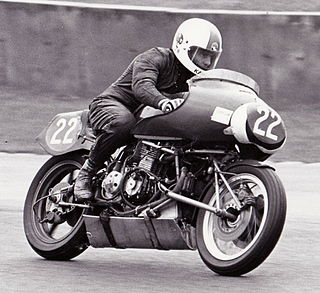
Mead & Tomkinson was a motorcycle and car dealership in Hereford Gloucester, and Tewkesbury. Three of the Tomkinsons, sons Chris and Patrick, and their father, Mike, successfully built and fielded racing motorcycles. They concentrated on the Isle of Man TT and on 24-hour and 8-hour endurance races at Spa, Barcelona, Thruxton and the Le Mans Bol d'Or. One of their riders was Neil Tuxworth.

BSA motorcycles were made by the Birmingham Small Arms Company Limited (BSA), which was a major British industrial combine, a group of businesses manufacturing military and sporting firearms; bicycles; motorcycles; cars; buses and bodies; steel; iron castings; hand, power, and machine tools; coal cleaning and handling plants; sintered metals; and hard chrome process.
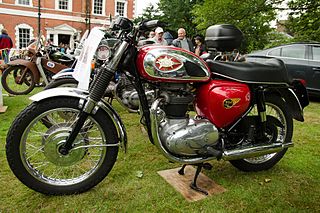
The BSA unit twins were a range of unit construction twin-cylinder motorcycles made by the Birmingham Small Arms Company (BSA) and aimed at the US market. A range of 500 cc (31 cu in), 650 cc (40 cu in) and 750 cc (46 cu in) twins were produced between 1962 and 1972, but they were really developments of the older pre-unit A7/A10 model range with less weight. The engines had a reputation for vibration, but acceleration was good for the time, to a top speed of 100 miles per hour (160 km/h).
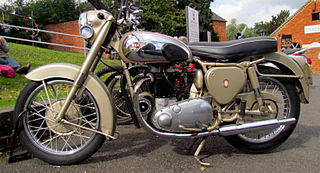
The BSA A10 series was a range of 646 cc (39.4 cu in) air-cooled parallel twin motorcycles designed by Bert Hopwood and produced by Birmingham Small Arms Company at Small Heath, Birmingham from 1950 to 1963. The series was succeeded by the A65 unit construction models.
